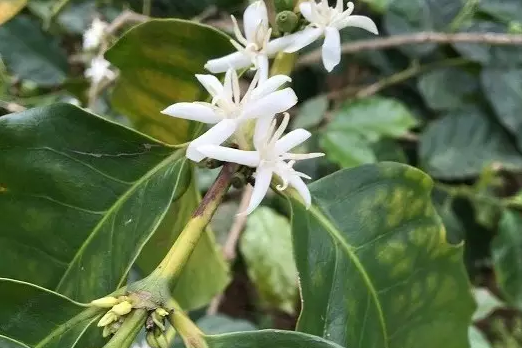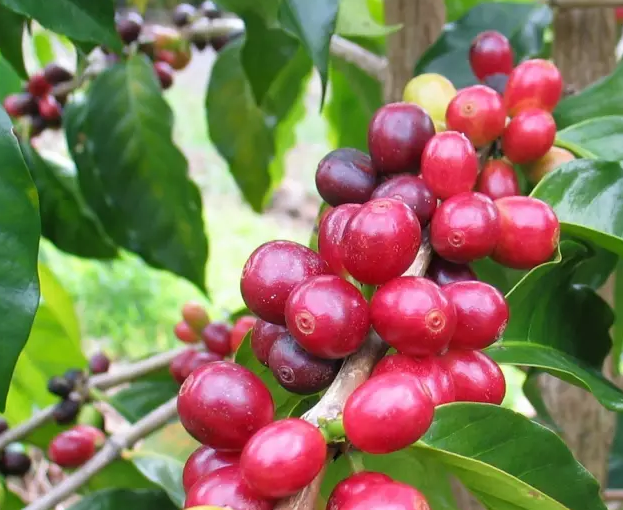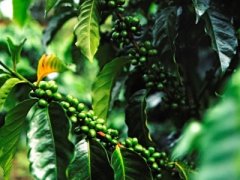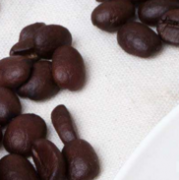Coffee trees introduce how to grow good coffee fruit sources from seeds to fruits.
Coffee is a perennial evergreen shrub or small tree of Rubiaceae, which is a horticultural perennial cash crop. Wild coffee trees can grow to a height of 5-10 meters, but coffee trees planted on manors are often cut to a height of less than 2 meters in order to increase the amount of fruit and facilitate harvesting.
Coffee trees bloom in February-March (Northern Hemisphere) or June-July (Southern Hemisphere), depending on the origin. The flower color is white, Corolla 5-lobed, reversing, sending out a strong aroma. Coffee flowers are similar to jasmine in appearance and smell. When they bloom, they grow in clusters on the branches of coffee trees, and the flowering period is about 3-5 days. Coffee trees take as long as 3-5 years from planting to fruiting. 6-10 years of coffee trees are the easiest to bear fruit, with a harvest period of about 15-20 years. The harvest time depends on the geographical location, climate and altitude, and varies according to the conditions of each producing area.

After the coffee blossoms, it slowly forms green coffee fruit. The immature coffee fruit is green, and after a ripening period of 6-7 months, the mature fruit skin is red. Coffee fruit grows densely along each branch, although it grows on the same branch, the ripening period of each fruit is different, some are still turquoise, some have turned slightly yellow, some are yellow, some are fully ripe bright red, and some are dry dark brown. Because it is not mature at the same time, manual picking is generally used when picking coffee fruits to avoid picking immature beans. It is hard for a farmer to pick coffee fruit, and the price is very low, so we should cherish every cup of coffee.
Most of the raw beans are flat beans, that is, the beans are round on one side and flat on the other, also called mother beans. A round bean (male bean) is a whole bean that is round and does not have a flat surface like flat beans. A coffee fruit will contain two seeds, the plane leaning against each other, and the round bean is formed because one of the two seeds dies, and the other one grows into a round bean. Round beans are not very special. Round beans are selected to make the beans appear more uniform visually and to avoid the flavor affected by the uneven heat in the baking process.

Important Notice :
前街咖啡 FrontStreet Coffee has moved to new addredd:
FrontStreet Coffee Address: 315,Donghua East Road,GuangZhou
Tel:020 38364473
- Prev

Roasting experience sharing in-depth analysis of coffee roasting skills and basics
Roasted coffee transforms the chemical and physical properties of raw coffee beans into roasted coffee products. The roasting process causes raw beans to expand and change their color, taste, smell and density, resulting in the special flavor of coffee. Unroasted coffee beans and roasted coffee beans contain similar acidity, protein and caffeine, but lack their good taste. The process needs enough heat to speed up beauty.
- Next

Coffee roasting skills basic knowledge, curve adjustment, flavor mastery
The flavor of coffee is largely determined by the qualification of raw beans, and roasting is only a way to show the characteristics of coffee beans. After roasting, various ingredients of raw coffee beans have undergone chemical changes, thus forming the flavor of coffee. In other words, what kind of chemical change occurs, to what extent, and to what extent to stop the reaction from continuing these are the main points of baking.
Related
- Beginners will see the "Coffee pull flower" guide!
- What is the difference between ice blog purified milk and ordinary milk coffee?
- Why is the Philippines the largest producer of crops in Liberia?
- For coffee extraction, should the fine powder be retained?
- How does extracted espresso fill pressed powder? How much strength does it take to press the powder?
- How to make jasmine cold extract coffee? Is the jasmine + latte good?
- Will this little toy really make the coffee taste better? How does Lily Drip affect coffee extraction?
- Will the action of slapping the filter cup also affect coffee extraction?
- What's the difference between powder-to-water ratio and powder-to-liquid ratio?
- What is the Ethiopian local species? What does it have to do with Heirloom native species?

